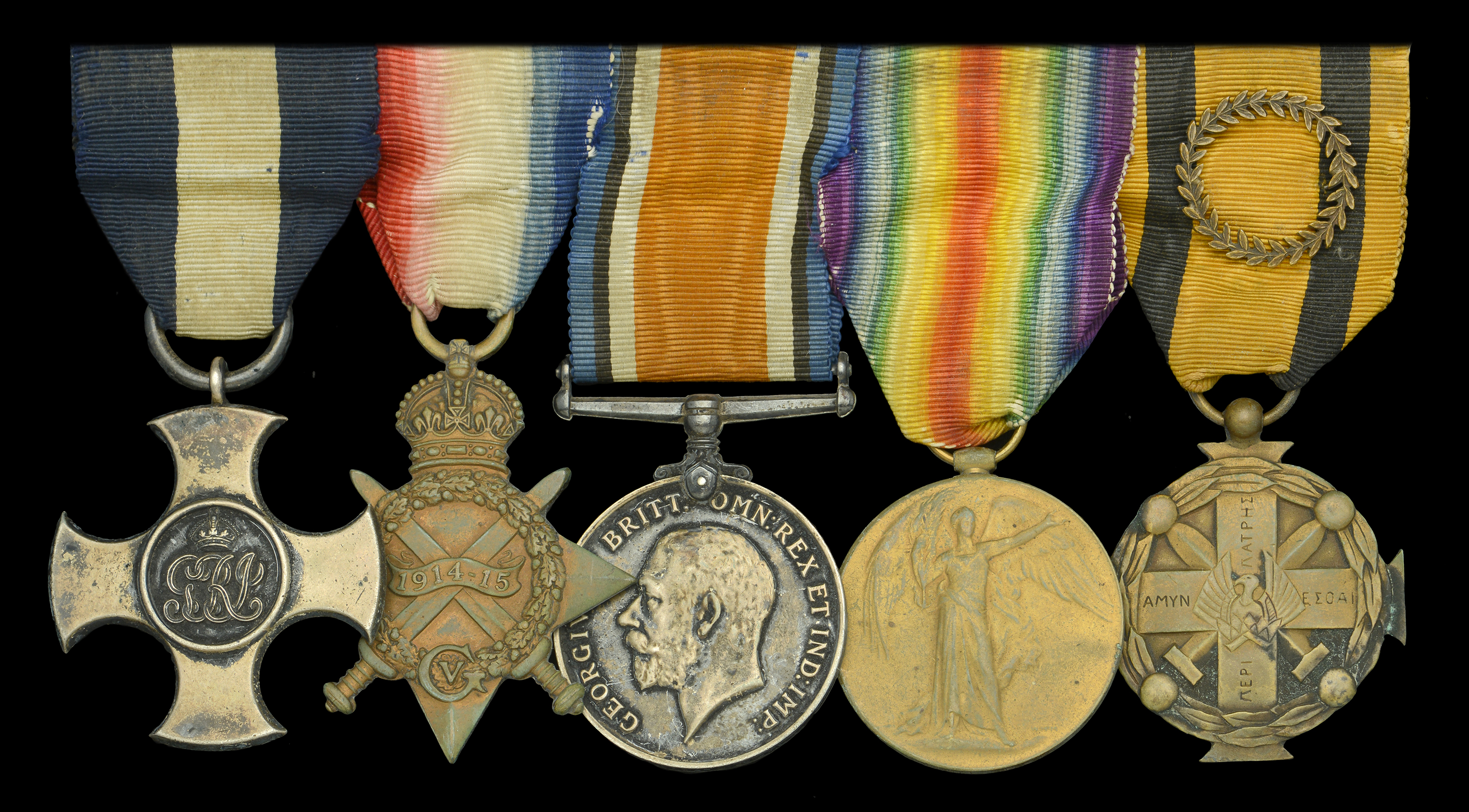A rare Great War Flight Commander’s D.S.C. group of five awarded to Captain J. C. Brooke, Royal Air Force, late Royal Naval Air Service Having participated in anti-zeppelin flights over London and patrols over the North Sea, he lent valuable service in seaplane carrier operations in Egypt and Palestine 1916-17, working under naval aviation pioneer Air Commodore C. R. Samson, C.M.G., D.S.O., A.F.C. Distinguished Service Cross, G.V.R., the reverse hallmarked London 1916; 1914-15 Star (Flt. Lt. J. C. Brooke, R.N.A.S.); British War and Victory Medals (Capt. J. C. Brooke. R.A.F.); Greece, Medal of Military Merit 1916-17, 3rd Class with wreath on ribbon, mounted as worn, some verdigris, otherwise very fine (5) £2,000-£3,000 --- Importation Duty This lot is subject to importation duty of 5% on the hammer price unless exported outside the UK --- --- D.S.C. London Gazette 20 July 1917: ‘In recognition of his services in the East Indies and Egypt Seaplane Squadron during the period 1 April 1916 to 31 March 1917. During this time, he took part in several valuable reconnaissance and bombing flights, obtaining important information and doing considerable damage to enemy organisations.’ John Callaghan Brooke was born in Kensington, London on 25 June 1893 and qualified for his aviator’s certificate (No. 908) in a Bleriot monoplane at Brooklands in September 1914. He was subsequently commissioned in the Royal Naval Air Service in November 1914 and undertook further training before flying operationally out of Calshot, Hampshire and Killingholme, Lincolnshire. He is credited with a flurry of sorties in The Air Defence of Great Britain, including anti-zeppelin patrols over London in March and June 1915, in addition to seaplane patrols in April and May 1916; he survived a ditching in the river Humber on 7 November 1915 and likewise in the North Sea on 25 March 1916. In May 1916, Brooke was ordered to Port Said, Egypt to join a squadron forming under Commander C. R. Samson, D.S.O., his flotilla comprising the seaplane carriers H.M.S. Ben-my-Chree, a former Isle of Man passenger steamer, and a pair of converted German prizes, the Anne and Raven II. And, as recounted by Samson in Fights and Flights, Brooke served with distinction over the coming months, in his case piloting one of Raven II’s seaplanes. His first sortie was a recce of El Arish on 1 July 1916, in which his seaplane was ‘exposed to a very heavy anti-aircraft fire.’ Samson adds, ‘this was Flight Lieutenant Brook’s first experience with us, and he did very well.’ Four days later, after Raven II had journeyed to French-held Castelorizo Island off the Asia Minor coast, Brooke was among those who made several ‘very extended flights’ and, in August, on being ordered to spot for a monitor charged with bombarding enemy positions at Bu El Mazas, he attacked a large camp. As related by Samson, he was in turn attacked by a German Fokker, ‘which of course was more than a match for a slow old Short with only a Lewis gun … The Short finally drove off the Fokker but suffered severely, having holes in the petrol tanks, radiators and floats. On alighting she began to sink; but smart work on the part of Lieutenant Jenkins, R.N.R., enabled her to be hoisted in.’ Brooke was back in action at the end of the month, when Samson’s flotilla contributed to a concerted attack on Turkish communications at El Afuleh. Raven II’s four aircraft were allocated to the railway line three miles south of Afuleh, where, by Samson’s own account, a reception of ‘hot fire’ was experienced. It was about this time that Samson received a message from the Admiralty, querying the high expenditure of ammunition from the squadron’s flagship. He replied that ‘there was unfortunately a war on.’ As it transpired, the Ben-my-Chree was sunk by Turkish gunfire in January 1917, but Raven II and Anne were fitted out for further operations in the Indian Ocean, searching for enemy commerce raiders. Brooke, who had been advanced to Flight Commander in December 1916, was awarded the D.S.C. and returned home to take up an appointment at Cranwell in July 1917. On the formation of the Royal Air Force in April 1918, by which stage he was operating in Sopwith Pups out of Turnhouse, he was appointed a Captain. He died in Poole, Dorset in September 1966; also see references to him in Royal Navy Shipboard Aircraft Developments 1912-31 by R. Cronin. For the recipient’s related miniature awards, see Lot 521.





